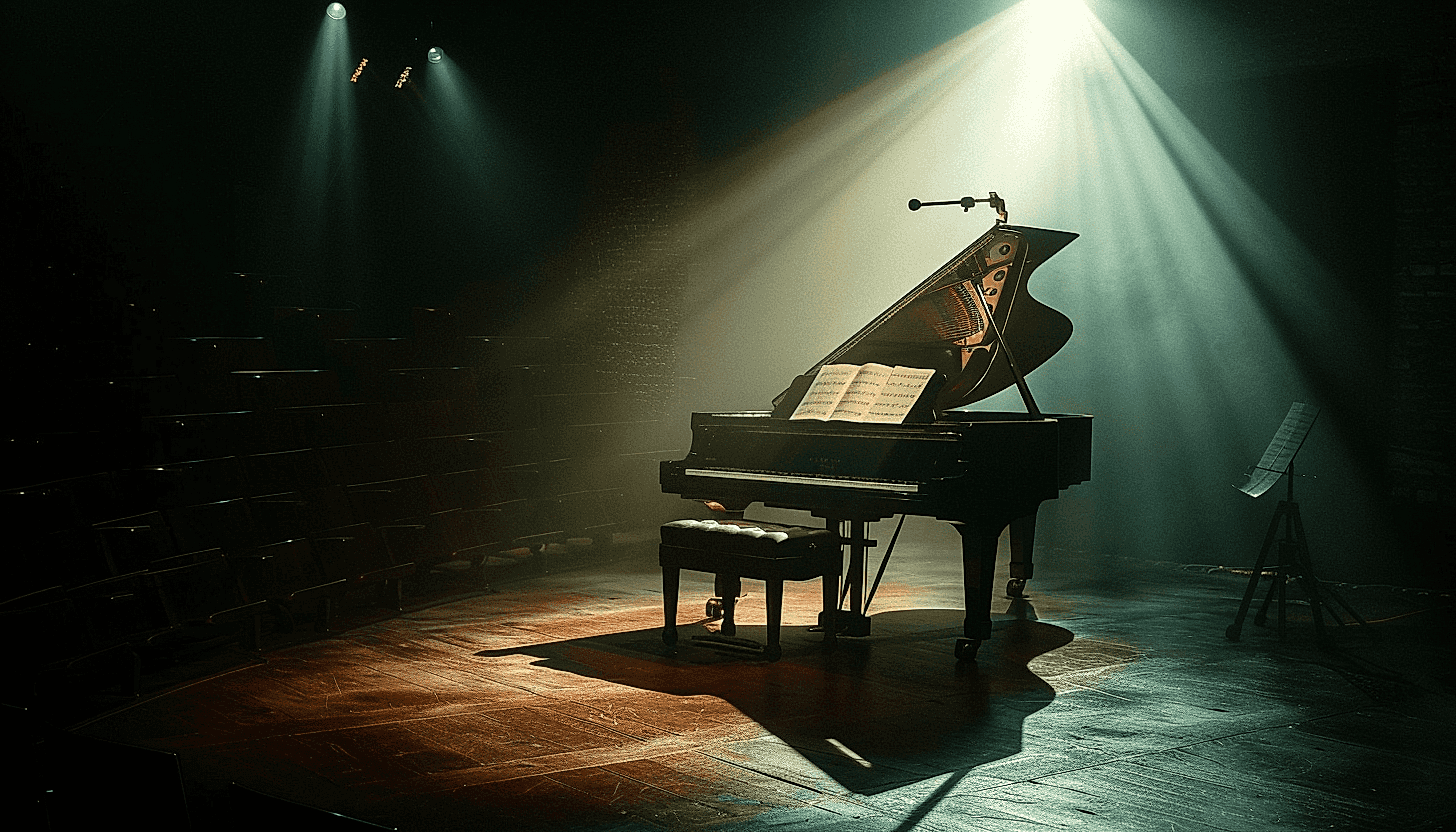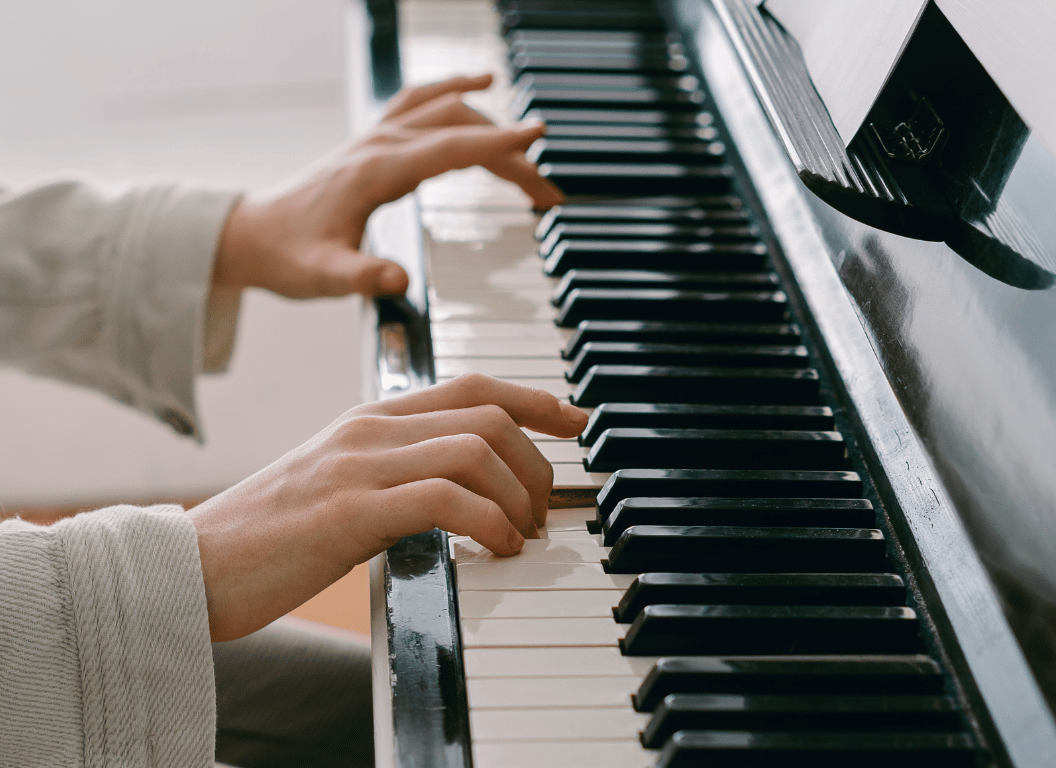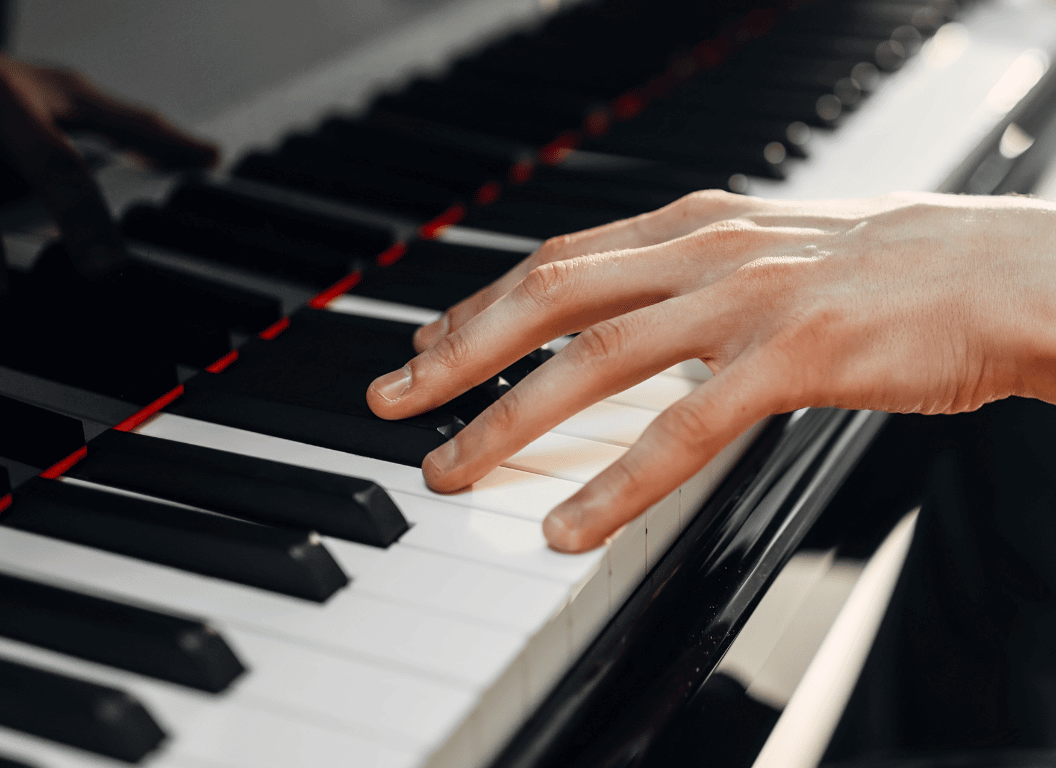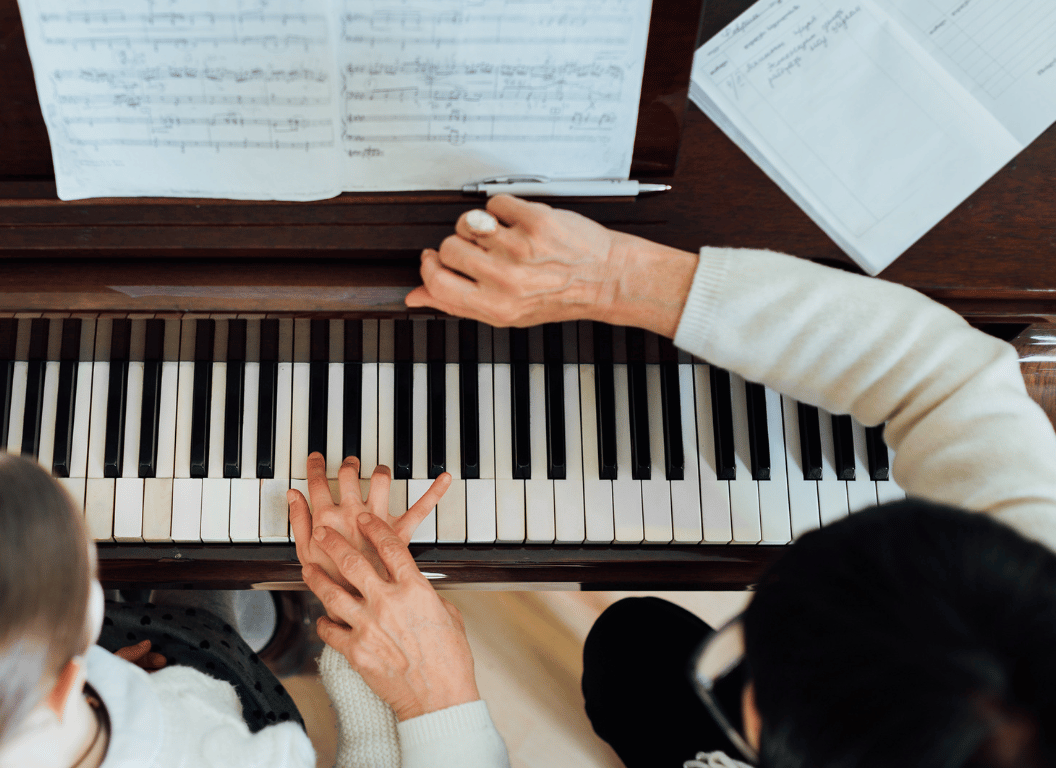It is fundamental to grasp the basics when starting out on the piano.
The process may seem daunting at first, and mistakes are part of the learning process.
The key to success is persistence and proper guidance.
This article aims to provide new players with valuable tips to enhance their piano skills.
We will delve into strategies that bring about effective learning and improvement.
By focusing on these crucial aspects, beginners can quickly progress and attain confidence in their playing ability.
- Understand and adopt the correct sitting position and hand posture.
- Begin your practice with scales and chords.
- Ensure daily practice sessions, even if they are brief.
- Pay close attention to the sound of each note.
- Utilize a metronome to keep a consistent rhythm.
While setting the proper posture and utilizing daily practice sessions are instrumental in your piano learning journey, there’s much more to discover.
In the coming sections, we will explore additional fundamental techniques and tips that will enrich your understanding and elevate your playing skills.
From mastering the core principles of music theory to nurturing your musical ear, these key insights will further pave the way for your progression in piano mastery.
Stay tuned as we unpack these topics, designed to reinforce your foundation and guide you in becoming a proficient pianist.
Contents
- Playing Tips Every Piano Beginner Should Know
- 1. Learn proper sitting position and hand posture
- 2. Start by Practicing Scales and Chords
- 3. Practice daily, even for short periods
- 4. Listen carefully to each note’s sound
- 5. Use a Metronome to Maintain Rhythm
- 6. Break Down Difficult Pieces into Sections
- 7. Sight-read New Pieces Regularly
- 8. Don’t Rush, Patience is Key
- 9. Practice with Both Hands Separately
- 10. Stay Relaxed to Prevent Injuries
- The Bottom Line
Playing Tips Every Piano Beginner Should Know
1. Learn proper sitting position and hand posture
In Short: The right sitting position and hand posture greatly enhances your ability to play the piano efficiently and effectively, reducing strain and preventing injuries. Understanding and maintaining these positions provides a solid foundation for your piano journey, positively affecting movement, concentration, and preventing muscular discomfort.
The sitting position and hand posture can often be overlooked but are fundamental aspects of learning to play the piano.
These two aspects can greatly influence your ability to efficiently and effectively play the instrument.
One might be surprised by the impact that proper sitting and correct hand position can have on the perceived difficulties or ease of piano playing.
Proper positioning eradicates unnecessary strain on part of the body due to awkward postures, which in turn, improves proficiency and prevents injuries.
Comfortably sitting upright is crucial. Slouching or leaning too forward can initiate tension and fatigue, disrupting the optimal concentration needed for practice.
Therefore, there are basic guidelines for the correct sitting position:
- The bench should be at a distance where, when arms are outstretched, your fingertips barely touch the keys.
- Your elbows should be slightly raised – about the same height as the keyboard.
- Keep your back straight, massaging a good posture.
- The feet must be flat on the ground, or if you are short, on a footrest.
Failure to follow these guidelines could lead to ineffective piano playing and can inevitably cause muscular discomfort or potential injuries over time.
Focusing on the hand, let’s delve into the appropriate positioning. A loose, rounded hand shape is often recommended, similar to holding a small ball.
Your fingers should be curved, falling naturally onto the keys. Your thumb should lie flat and the little finger on its side.
Particularly important here is the wrist mobility; it should be flexible and free from tension.
The hand should be poised in a way that allows for easy movement and quick reflexes.
Moreover, it is important to note that the fingers should not be too tense or too relaxed, thus maintaining a balance is needed.
Thorough understanding and maintaining proper sitting position and hand posture will provide a solid foundation for your piano journey.
I encourage you to watch the following YouTube video that will bring immense value to your pursuit of mastering piano fundamentals.
This video dives deep into the correct ways of sitting and configuring hand posture while playing the piano.
It is an excellent tool in initial stages to avoid developing harmful habits that may impede your progress or contribute to injuries over time.
Its detailed explanations and demonstrations are not only simple to follow but also effective in building a solid foundation.
By adapting these fundamentals explained in the video, you will gain more control over your piano playing and move one step closer to sounding like a pro.
2. Start by Practicing Scales and Chords
In Short: Practicing scales and chords forms the basis of learning to play the piano and builds an understanding of musical theory. Regular practice, setting a consistent tempo, gradually increasing speed, and inclusivity of chords in practice sessions aids in mastering the instrument.
Being a beginner in the fascinating world of piano playing, it’s advised to start by practicing scales and chords. This approach is a fundamental building block in learning how to play any musical instrument, especially the piano. It is not just a baseless recommendation; there’s a sea of wisdom behind its importance.
Scales and chords form the foundation of music theory. They are the building units that will help later on to address far more complex compositions. Furthermore, practicing scales fosters a deeper understanding of different musical keys, which is a central aspect of piano playing.
The beauty of scales lies in their repetition. Each octave, regardless of where on the keyboard it’s played, has the same scale pattern. Practicing scales is a great way to build skill consistency over the entire piano. It reinforces your skill in playing similar tunes across different octaves.
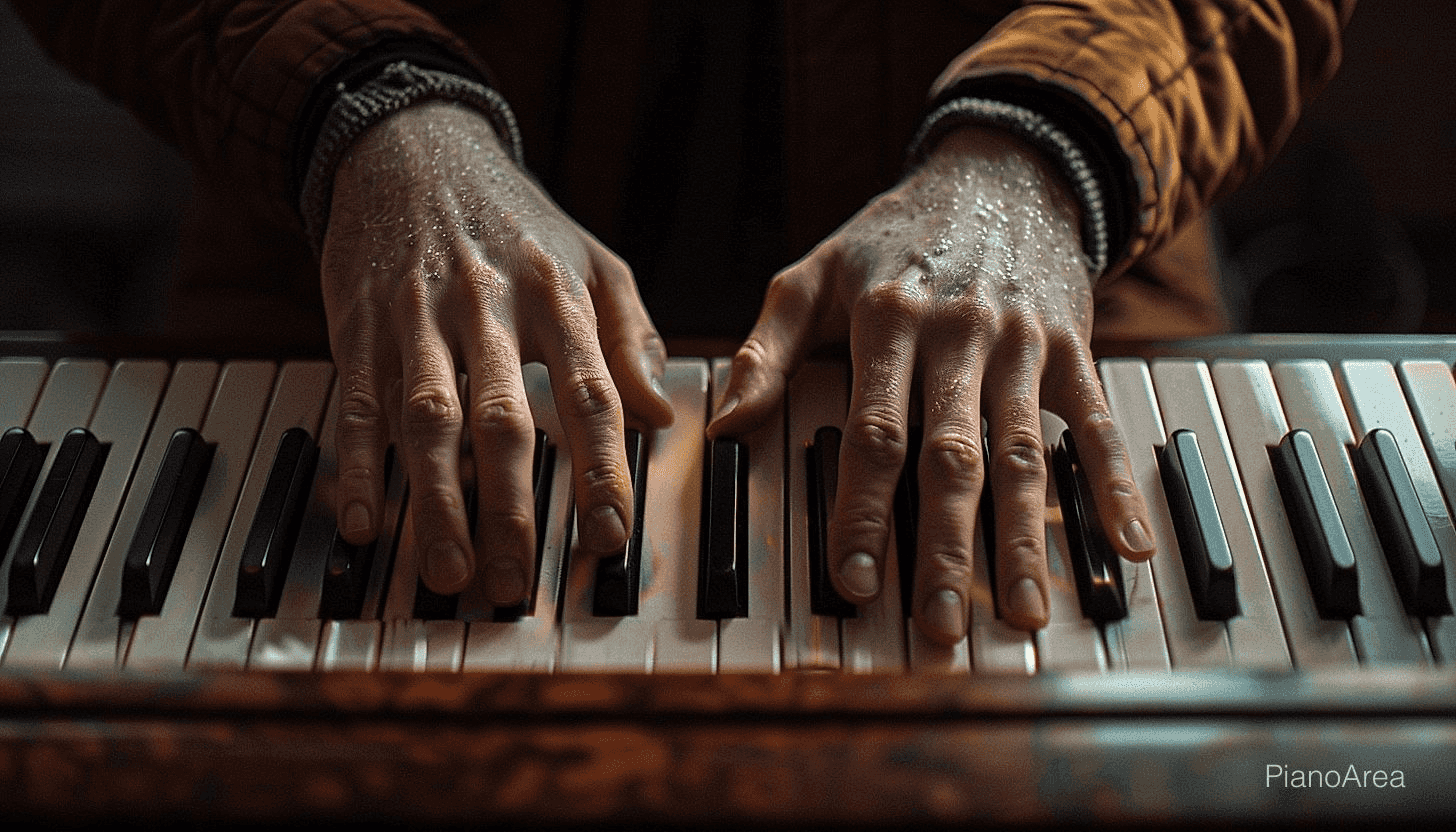
Now, you might be wondering about the best way to practice scales and chords. Here are a few strategies:
- Learn one scale at a time: It’s essential not to overwhelm yourself. Start with the C Major scale, master it and gradually move on to others.
- Practice regularly: Consistency is the key to piano mastery. Regular practice will help your fingers become accustomed to the piano keys.
- Incorporate chords: Integrating chords within your scale practice will diversify your exercise, making it more interesting and less monotonous.
- Use a metronome: A metronome can assist you in keeping a consistent tempo, enhancing rhythm accuracy during practice.
- Gradually increase tempo: Start slow and steadily increase your tempo. It will not only help in polishing your skills, but it’s also a good benchmark to track your progress.
Moreover, chord practicing treads along the similar line as scale practicing. Chords are the backbone of harmony and provide the character and personality to the melody. An understanding of chords will help you interpret, learn and remember music in the longer run.
Practicing chords also enhance your piano playing techniques. It helps to promote hand-eye coordination, as well as the independent movement of fingers, which is crucial in piano playing. You’ll notice benefits not only in your technical skills but also in your creative expression.
Pro Tip: To effectively master the piano, start your practice with scales and chords as they form the foundation of music theory and increase understanding of different musical keys.
Believe it or not, it’s not just about playing the right notes. Effective piano playing is also about the understanding and respect towards musical theory. Scales and chords are a great way to gradually foster that understanding.
In the end, practicing scales and chords is your first step in mastering the piano. It paves the path for advanced lessons and is the simplest, yet most effective technique to build your musical theory knowledge.
3. Practice daily, even for short periods
In Short: Daily piano practice is crucial for effective learning, regardless of its duration; short, quality sessions can be just as beneficial as lengthy ones. Strategies for effective practice include having a consistent practice space, focusing on specific sections of a piece, practicing slowly, taking small breaks, and maintaining a practice log.
One of the most critical pieces of advice for beginners learning how to play the piano is to develop a habit of daily practice. Playing the piano is like learning a new language; consistent exposure and practice are what will make the process easier and more effective.
You might think that extensive, lengthy sessions are the key to mastering this instrument, but it’s actually more about consistency. It doesn’t really matter if you can only spare twenty or thirty minutes a day; the crucial part is doing it every day.
What matters more than the duration of your practice sessions is the quality of the practice. Practicing thoughtfully and attentively, even for short periods, can be more beneficial than mindlessly playing for hours without focus.
The beauty of short but consistent practice sessions is that they can easily fit into anyone’s day regardless of their schedule. By setting out realistic and achievable practice goals, you can easily accumulate valuable hours of practice over time without feeling overburdened.
Here are a few strategies to make short practice sessions more effective:
- Determine a consistent practice space: Having a dedicated spot for your piano practice not only minimizes distractions but also psychologically prepares you for a focused session.
- Work on specific sections of a piece: Instead of running through an entire piece, work on a small troublesome section. This technique, often referred to as “spot practicing,” aids in mastering complex pieces and is an efficient use of limited practice time.
- Practice slowly: Slowing down and focusing on each note will enforce muscle memory and improve sight-reading over time. Restrictions on speed might prevent mistakes from creeping in and becoming habits.
It’s also beneficial to maintain a practice log where you keep track of what you practiced each day. Documenting your progress can help you identify where you need to improve and can motivate you by showing you just how much you’ve accomplished over time.
Another critical aspect of effective practice to keep in mind is to take small moments of rest when you start feeling tired or overwhelmed. Taking small breaks during your practice sessions can actually increase your productivity, focus, and the quality of the practice.
And as much as we all have a desire to master a piece quickly, remember that learning the piano is not a race. Avoid rushing to learn everything hastily; take your time and enjoy your newfound skill . Even if what you’re playing is simple, take joy in the progress you’ve made from just being able to hold a simple tune.
I want you to remember, dedication and consistency are important in your journey to becoming a skilled pianist. Even if progress seems slow, don’t be daunted. Steady and incremental progress will eventually lead you to mastery.
I highly recommend you to take the time to view a particular YouTube video that can be a considerable aid to your piano practice.
This video presents a comprehensive practice routine specifically designed for beginners, providing step-by-step guidance to your daily exercises.
The instructions in the video are clear and easy to follow, which makes it a user-friendly tool for learners at any stage.
In addition to technical exercises, the video also emphasizes the importance of regular and consistent practice, even for short periods, which is in line with the topic of our section.
Implementing the techniques and routines suggested in this video can substantially enhance your practice, and you will notice an improvement in your skills in no time.
4. Listen carefully to each note’s sound
In Short: Listening attentively to each note’s sound is crucial in piano playing, aiding in understanding tonal variations, improving pitch recognition abilities and timing. Developing auditory skills, hearing subtle differences in sounds, and employing strategies such as visualizing the sound, slow play, repetition, and playing by ear will enhance your piano performance and enrich your musical journey.
As piano beginners, we often concentrate on the essential skills of finger positioning, understanding musical notation, and hitting the right keys. While these aspects are important, there is another integral component, which is often missed out: the art of listening carefully to each note.
In order to build a strong foundation in piano playing, one should heed the importance of developing the auditory skills, and make it a point to actually listen closely to each note played, not only to ensure correctness but also to understand the nuances of piano sound.
At first, all piano notes may seem similar to an untrained ear, with only the pitch varying. But upon closer listening, you will find that each note has its unique character and emotion, depending on how you play it.

The beauty of piano lies in the detailing of sounds and their use to convey emotions. Therefore, each note deserves undivided attention.
Now to achieve this, let’s have a brief run-down on some strategies:
- Visualizing the Sound: Try to picture each note in your mind. This can help you to understand the sound better.
- Slowing Down: Do not rush through your practice. Play each note slowly to thoroughly understand its sound.
- Repetition: Regularly repeating a note can familiarize you with its sound.
- Playing by Ear: Try to reproduce the sound of a note without looking at the keys. This can enhance your hearing skills.
To truly master the piano, listening to each note and understanding its tonal variations is paramount. This practice not only contributes to your musical sense but also plays a significant role in improving your pitch recognition abilities and sense of timing.
When you start listening to individual notes attentively, you might hear the subtle differences in sound, depending on the pressure applied, the duration for which it was held, or even the change in room temperature. All these minor details begin to matter in the overall output of your performance.
It’s not straightforward, and it takes time, like anything worth achieving. Rushing through this process can lead to a weak foundation and an unstable musical understanding.
The progress might be slow, but the resultant capability to extract and enjoy the richest, fullest, and most diverse palette of sounds from the piano is incredibly enriching. It elevates the performance from a mere rendition of notes to a full-fledged musical narrative.
Hence, remember when you settle down next time for practice, start with a quiet mind, take a breath, and keenly listen to each note’s sound. This simple practice can bring a noticeable difference in your piano playing skills and enhance your musical journey.
5. Use a Metronome to Maintain Rhythm
In Short: Using a metronome helps pianists maintain rhythm, enhance musical abilities, and identify difficulties in timing. Consistent practice with a slow tempo, understanding beats-notes relationships, and gradual tempo increase are crucial methods for effective metronome use.
One of the key aspects of becoming a proficient pianist is to understand and maintain rhythm. In music, rhythm is used to give a sense of timing to the tunes and melodies we create. One of the ways to achieve rhythmical precision when playing the piano is by learning how to use a metronome.
A metronome is a device that produces a steady beat at a selected tempo, helping the musician synchronize their performance with an exact tempo. As a beginner, using a metronome can seem challenging. However, with consistent practice, it can do wonders in improving your rhythm and timing.
When you start using a metronome, it’s important to begin with a slow tempo. Trying to keep up with a fast beat can prove to be discouraging for a beginner. Always remember, it’s about maintaining the rhythm, not speed.
The next step is to understand the relationship between the beats and the notes. Each note symbolizes a distinct duration of a beat or multiple beats in a musical composition. When playing, you will have to synchronize each note with the beat produced by the metronome.
Practicing with the metronome helps you internalize these beat-note relationships, thereby making you a more confident and precise performer.
Another advantage of using a metronome is that it helps you identify your difficulties in maintaining a rhythm. The constant beat allows you to immediately spot inconsistencies and work on those parts of the composition where you falter the most.
Below, let’s take a closer look at some of the key pointers to remember when using a metronome:
- Start with a slow tempo – Rushing to play at high speeds can inhibit learning.
- Learn the beats and notes relationship – Understand the duration represented by each note type and how it relates to the metronome beat.
- Use metronome as a tool for self-assessment – Recognize the parts where your rhythm gets inconsistent and use the metronome to fine-tune those areas.
- Gradually increase the tempo – Incrementally increase the speed as you get comfortable with the slower beats. Keep in mind, rhythm before speed.
It’s important to note that the metronome is just a tool. Don’t become overly reliant on it. The goal is to internalize the rhythm so that it becomes second nature, and you can maintain your tempo even without the metronome.
Important: Using a metronome, which produces a steady beat at a chosen tempo, can greatly improve your rhythm and timing when playing the piano, and it is especially effective when practiced consistently and with patience.
The key to effectively using a metronome lies in your patience and consistency. It’s an incremental process, and rushing through it will only result in frustration. So be patient, practice consistently, and you will definitely see the improvement in your piano playing rhythm.
With consistent practice, a metronome can help you enhance your musical abilities enormously, making you a better pianist who can play with accuracy, confidence, and a pleasing rhythm.
I encourage you to watch a certain YouTube tutorial that I believe will be extremely beneficial to your piano practice.
This digital guide provides detailed instructions on how to effectively incorporate a metronome into your musical routine.
Offering clear and practical insights, it sheds light on the workings of this indispensable tool and how it can help you maintain a steady rhythm while playing.
By closely following the steps outlined in this tutorial, you will be able to improve your timing and increase your musical precision.
Not only will it enhance your skill, but it will also contribute to a richer and more enjoyable piano playing experience.
6. Break Down Difficult Pieces into Sections
In Short: Throughout your piano journey, breaking complex pieces into smaller manageable sections can speed up your progress and enhance focus on individual notes or chords. Always identify natural breaks in the music, practice each section separately focusing on accuracy, maintain a steady tempo, and gradually mesh sections together, making sure to transition slowly to avoid mistakes.
Throughout your piano learning journey, you will undoubtedly stumble across pieces that might seem overwhelmingly complex at first glance.
One helpful tip is to break down these difficult pieces into smaller, more manageable sections.
This method is not merely about simplifying the process; it also enables you to focus intensely on each section and pay closer attention to the individual notes or chords.
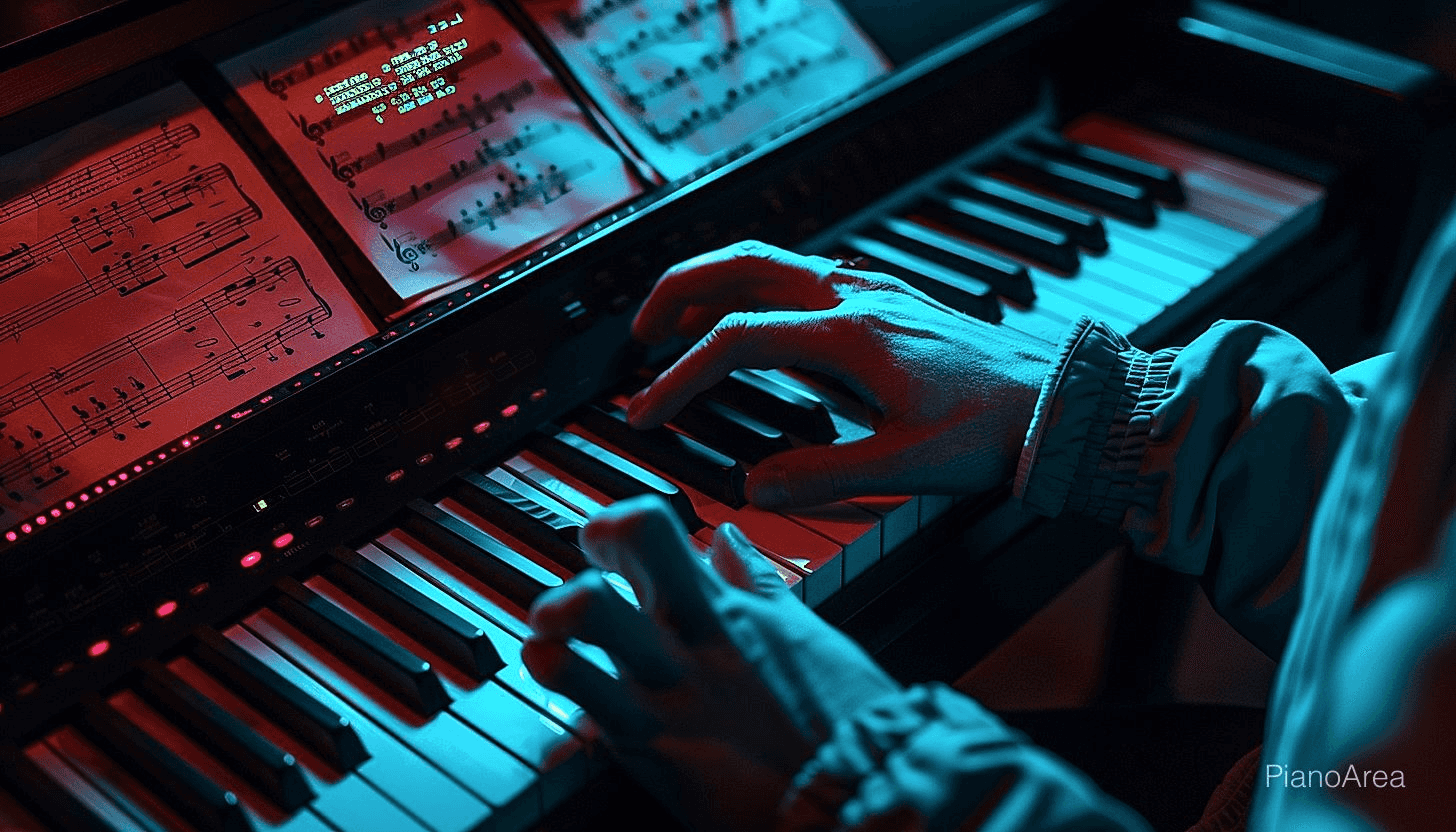
Progress is often quicker and more meaningful when it’s broken down into small but consistent steps.
Now, you might wonder, ‘How should I go about breaking down the pieces correctly?’
Firstly, you need to identify potential sections within the piece.
These sections could be dictated by various factors like a change in tempo, tune, key, or rhythm.
Essentially, they are parts of the piece that stand out differently from the rest.
Before tearing the piece apart, here’s a simple method you might find useful:
- Identify natural breaks in the music- perhaps a pause, or a change in key or tempo.
- Highlight these parts and start practicing them individually.
- Practice each section slowly, focusing on accuracy and understanding each note.
- Maintain a steady tempo, not speeding up, despite the urge to do so.
- Once comfortable, start meshing all of the sections by practicing sections together.
Consistently working on individual sections will allow you to perfect each one separately while also providing a sense of accomplishment and motivating you to continue.
It’s crucial to keep in mind that while practicing these sections, the ultimate aim is to play the piece as one seamless flow.
Let me tell you, once you’re comfortable playing individual sections, start slowly combining them together.
However, go slow. Transitioning from one section to another is often challenging, and rushing through it can lead to mistakes and frustration.
Learning to play the piano can be a challenging journey, but by breaking down difficult pieces into sections, you can simplify the process and make it more enjoyable and rewarding.
It’s important to remember, patience and consistency are key, and with these tips, you’ll soon be able to conquer those complex pieces with ease.
7. Sight-read New Pieces Regularly
In Short: Regularly sight-reading new pieces is one of the most effective ways to improve your piano skills as a beginner, offering a better understanding of rhythm, dynamics, and overall musicality. With a focus on gradual learning, repetition, and embracing diverse genres, sight-reading can enhance your musical literacy, interpretation skills, and enjoyment of playing piano.
One of the most effective methods to improve piano skills for beginners is to regularly sight-read new pieces. Sight-reading, by definition, is the ability to read and play music at first sight. This skill is not merely about accurately capturing the notes on a page, but it’s also about understanding the rhythm, dynamics, and the overall musicality of the piece.
As a beginner, sight-reading may pose a challenge initially. But like any other skill, it gets better with consistent practice and effort. It will not only enhance your musical literacy and understanding, but it will ultimately make learning new pieces of music much more comfortable and enjoyable.
When sight-reading, the emphasis should not just be on playing the piece flawlessly but rather understanding the piece’s structure, nuances, and rhythm. This honest approach to sight-reading builds a solid foundation and progresses your journey as a growing pianist.
In taking the steps to develop your sight-reading skills, there’s a productive sequence to follow, which can optimize your learning. Here’s a handy list to guide your practice:
- Start Small – Initially, sight-read short and straightforward pieces. Do not be overly ambitious by choosing advanced pieces with complicated key signatures or rhythms. The initial aim is to build confidence.
- Count Your Beats – Keeping track of the rhythm and beats is important in sight-reading. It helps to establish a strong sense of rhythm and enhances musical understanding.
- Slow Down – There’s no rush to play at the indicated tempo of a piece. Just take it slow and ensure you’re hitting the correct notes.
- Repeat – Repetition is key. Try to sight-read the same piece multiple times to familiarize yourself with different structures and patterns.
Regular sight-reading breeds familiarity with the piano layout, the music’s flow, the key changes, and shifting dynamics. This familiarity allows you to make fewer errors over time and remember pieces more quickly.
Additionally, sight-reading sharpens your musical instinct. As you grow accustomed to different musical pieces’ patterns and structures, you will begin to anticipate what comes next. It not only accelerates the learning process but also makes interpreting and understanding music intuitive.
Choosing diverse pieces for sight-reading can also expand your musical tastes and knowledge. This opens your mind to different styles and genres, enhancing your versatility as a pianist. It makes you capable of navigating various types of music and brings depth to your musical understanding.
Moreover, sight-reading is a crucial skill if you aspire to collaborate with other musicians or play in an ensemble. Musicians often sight-read music together during rehearsals. If you can sight-read efficiently, you will not only keep up with others but also contribute significantly to the group’s cohesion.
Lastly, remember that sight-reading is not a test but a journey. It’s not about attaining perfection, but about continuous improvement. It’s okay to make mistakes and learn from them. The aim is to enjoy the process of uncovering a new piece of music, understanding its essence, and interpreting it on the piano.
With regular practice, patience, and a positive mindset, sight-reading can become an incredibly rewarding part of your piano learning journey.
I highly recommend you check out a certain YouTube tutorial that I found extremely beneficial.
This tutorial dives into the art of improving piano sight-reading skills.
Its explanations and demonstrations, based on tried and tested methods, will help you significantly enhance your ability to sight-read new piano pieces.
The content presented is easy to follow and put into practice, making this tool undeniably practical for any aspiring pianists seeking advancement in this area.
By applying the techniques highlighted in this tutorial, you will have a firm foundation on which to develop and excel in piano sight-reading.
8. Don’t Rush, Patience is Key
In Short: Learning to play the piano requires commitment, consistent practice, and above all, patience. Rushing the process can lead to frustration, potential injury, and possible loss of motivation, while a steady, patient approach allows for real mastery and a deeper connection with the instrument.
For anyone embarking on the journey of learning the piano, it’s easy to fall into the trap of wanting to rush the learning process.
Piano mastery is not about quick wins or instant gratification; it’s about consistent and committed practice, which will, over time, result in proficiency.
Needless to say, patience is an indispensable virtue in this process.
Don’t forget, Rome wasn’t built in a day, and neither will your piano skills be.
Now, let’s take a moment to examine why patience is so important to this journey.
- Understanding and implementing musical concepts takes time.
- Muscle memory, which is crucial for playing the piano, takes a while to develop.
- Piano practice is also physically taxing. Rushing can lead to injury, hampering your progress in the long run.
Let’s not forget, even the most celebrated pianists have spent countless hours honing their skills – it’s the accumulation of those hours of practice that makes them so impressive.
Those who insist on rushing often end up feeling frustrated when they fail to yield the desired results.
This frustration can lead to a lack of motivation or even giving up piano entirely, and that’s not what we want.
It’s important to understand that the path of piano mastery is a marathon, not a sprint.
Patience, dear reader, is your best friend in this journey.
It’s not just about practicing patiently, it’s also about listening patiently, correcting mistakes patiently, and embracing the learning process patiently.
The saying, ‘slow and steady wins the race’ holds especially true when it comes to playing the piano.
By adopting a careful and steady approach, you allow yourself the time and space to truly experience and explore the piano.
You give yourself room to make mistakes, learn from them, and thereby improve over time.
Pro Tip: As you embark on your journey of learning piano, remember that patience is essential for mastering the instrument, as it involves understanding and implementing musical concepts, developing muscle memory, and avoiding physical injury from rushing the process.
Along with the technical skills, this journey is also about cultivating a connection with the instrument, which, like any relationship, takes time to build.
Let me tell you, remember to be patient with yourself as you take on this beautiful journey of self-discovery and growth through music.
9. Practice with Both Hands Separately
In Short: Practicing piano with both hands separately helps improve dexterity and memorization, with each hand following its own rhythm, tone, and pattern. Establishing a personalized routine, following piano fingering rules, and utilizing practices such as using a metronome can enhance your capability to maintain rhythm and synchrony between both hands.
As you progress and begin to master the basics of piano playing, you’ll notice that some pieces require the use of both hands independently. This can indeed be a challenging feat for beginners.
What you want to understand at this point, is that every hand has its rhythm, tone, and pattern that it must maintain throughout the play. This is very important in creating harmony and distinction in your music.
When first starting out, it can be beneficial to practice with both hands separately. You may find this easier as it allows you to focus on each hand’s movement individually.
By breaking down a piece into sections (as advised in tip 6) and practicing each hand separately, it becomes more manageable to memorize the movements required by each hand.
This strategy can greatly improve your dexterity and overall performance. It’s also a useful way to overcome the initial difficulty of mastering pieces that require the musician to play different melodies or rhythms with each hand.
A crucial respect to address here is to follow the appropriate piano fingering rules. They were designed to benefit you in performances like these. Ensure that each finger number coordinates with a specific key to bring about the desired note.
The choice of which hand to begin with when practicing can be subjective. Some beginners might find it easier to start with their dominant hand, others might prefer the opposite. The important thing is to develop a routine that works for you personally.
Here are a few steps you can follow when practicing with both hands separately:
- Choose a small section of the piece you would like to focus on.
- Practice, practice, practice this particular section with one hand until you are very comfortable with it.
- Switch to the opposite hand and do the same.
- Once you’re confident with both hands, start practicing them together but at a slower pace.
Don’t forget, over time, these patterns will become second nature. This is where the diligent practice and repetition come into play.
Gradually, you’ll gain the ability to synchronize your two hands to produce a harmonious tune. It is highly satisfying to listen to the results of your hard work.
Learning to play the piano should be a journey of enjoyment and fulfillment. Enjoy the process as much as the end result. The joy you experience on the way is a great part of playing the piano.
Everyone learns at their own pace, so don’t rush but remain diligent and committed. Patience, as reiterated in tip number 8. Patience is very paramount.
Important: Practicing with both hands separately is a beneficial strategy that can improve your dexterity and overall performance, helping you to overcome the initial difficulty of mastering pieces which require you to play different melodies or rhythms with each hand.
Also, keeping our tip 5 in mind, practicing with a metronome can drastically improve your ability to maintain rhythm and synchrony between your two hands.
It’s important to understand that every beginner’s journey is unique. Stick with what works best for you. Practice, patience, and enjoyment are the keys to piano mastery, especially when practicing with both hands separately.
For further knowledge, here is a great YouTube link I found that you will surely find useful:
This particular material focuses on the tactical aspect of piano playing, specifically involving the use of both hands.
Why is this important? The advantage of learning to play piano with both hands separately is that it allows you to understand and realize the unique role each hand plays, effectively enhancing your musicality and dexterity.
The exercises demonstrated in this creation are beginner-friendly, designed to gradually increase in complexity thus aiding in the enhancement of your skill level without overwhelming you.
I encourage you to invest some time into this learning aid as it provides ample tips, techniques and practices that will cultivate your potential to become an accomplished piano player.
10. Stay Relaxed to Prevent Injuries
In Short: Maintaining relaxation while playing the piano can help prevent injuries, enhance performance, and ensure overall health. This includes monitoring body tensions, maintaining good posture, taking regular breaks, practicing mindful breathing, and setting achievable practice goals.
When it comes to piano playing, one of the critical points to remember is the importance of maintaining relaxation during practicing or performing.
The body, particularly the hands and arms, should always be in a relaxed, natural state. Forcing or straining yourself could, over time, lead to injuries such as carpal tunnel syndrome or tendonitis, which could negatively affect your piano playing ability, and overall health.
Unnecessary tension not only has the potential to cause injuries but can actually hinder your progress improving your performance. This is because tense muscles can limit the execution of fluid movement and delicate touch.
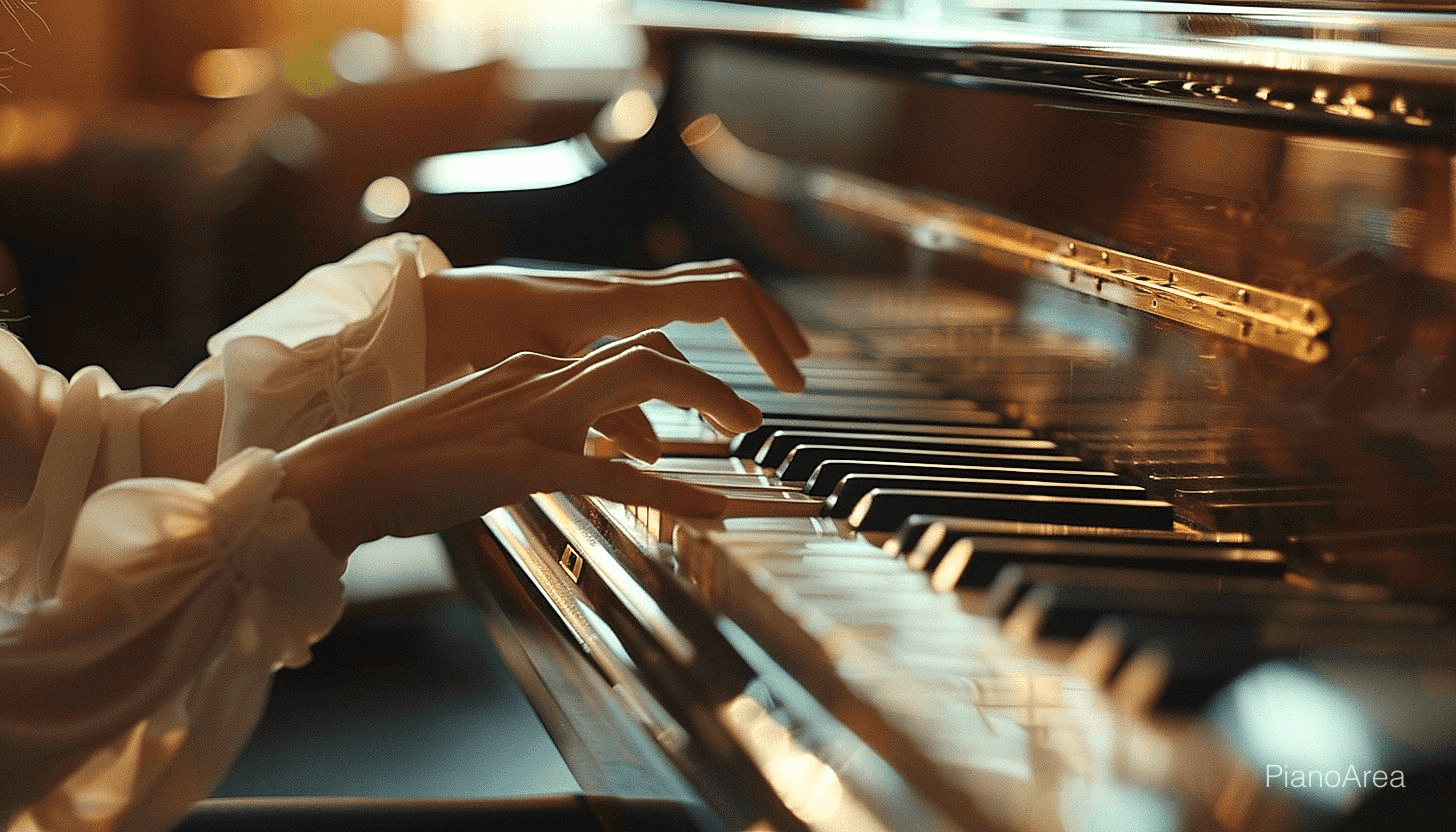
How do you keep relaxed while playing, you might ask? Well, it all starts with being aware of your body. Body awareness is crucial. Monitor your body for any signs of tension, not just in your hands and arms, but also in other parts like your shoulders, neck, and back.
The key to maintaining relaxation during piano playing lies in these main points:
- Awareness: Stay mindful of how your body feels while you play. Notice any tension and try to ease it.
- Breathing: Focus on your breath, making sure it is steady and even. When we are tensed, our breathing tends to become shallow.
- Breaks: Schedule regular breaks during practice sessions. Taking frequent short breaks allow your muscles to rest and prevents muscle fatigue.
- Posture: Good posture is crucial, improper posture can stress your body and promote muscle tension.
Another essential factor to consider is your practice duration. Long hours of practice without breaks can lead to fatigue and heighten the risk of injury. While it’s important to commit to regular practice, it is equally important to do so intelligently and attentively to your body’s signals.
One of the reasons why beginners might feel the need to overpractice is because of the pressure to perform. While having goals and aspirations are good, it’s essential not to allow this to turn into a self-pressure scenario.
To avoid this, set practical and attainable practice goals. It’s better to focus on learning one page of a piece perfectly, rather than rushing through the entire piece with mistakes.
Furthermore, being mentally relaxed is equally as important as being physically relaxed. A calm mind allows for better focus, which in turn may ensure a better performance.
I want you to remember, the key to piano mastery isn’t just about how often and how hard you practice, but also about practicing safely and effectively.
Lastly, always remember that it’s okay to make mistakes and not to be too hard on yourself. After all, making mistakes is part of learning and growth.
The Bottom Line
Adapting and perfecting your piano playing skills requires consistent practice, persistent learning and an open mind to embrace various dynamics.
Passion and determination are catalysts towards making the most out of the piano playing tips shared, hence every beginner piano player should strive to have an unyielding positive attitude.
Fine-tuning your touch, understanding piano dynamics, playing by ear, mastering the piano pedals and a commitment to regular practice, have been emphasized as some of the essential facets to achieving a beginner’s best.
Lastly, no one ever explores it all, hence beyond these tips, never stop learning, growing and exploring new ventures as a pianist. Your ultimate mastery resides in your unending quest for knowledge and enhancement of skills.

